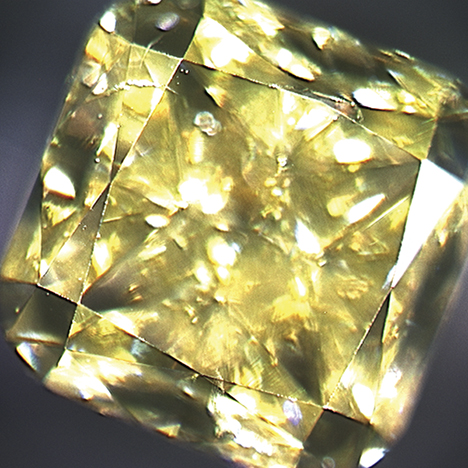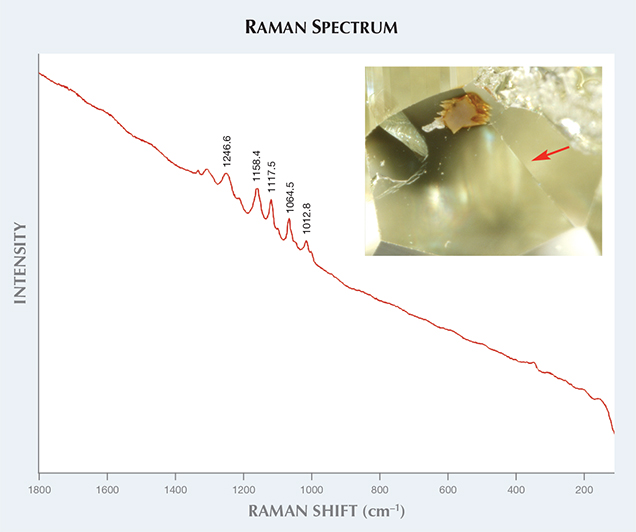Xenotime Inclusion in Yellow Diamond

Figure 1. This 0.55 ct yellow diamond contained a rare mineral inclusion of xenotime.
Photo by Kyaw Soe Moe.
The yellowish brown inclusion was located in the pavilion near the girdle; radiation stains were observed at the contact area with the host diamond (figure 2, inset). Radiation stains and the nature of the surface penetration suggested that it formed inside an etch channel as an epigenetic inclusion. Raman spectroscopy showed peaks consistent with xenotime at 1012.8, 1064.5, 1117.5, 1158.4, and 1246.6 cm–1 as seen in the figure 2 spectrum.Photo by Kyaw Soe Moe.

Figure 2. The xenotime inclusion broke through the pavilion surface (inset; magnified 80×). Radiation stains were also observed at the contact with the host diamond (see arrow). The Raman spectrum, using a 514 nm laser, shows xenotime peaks at 1012.8, 1064.5, 1117.5, 1158.4, and 1246.6 cm–1. Photomicrograph by Kyaw Soe Moe.
Minerals that formed outside of the diamond stability field can be found inside a diamond (see Spring 2009 Lab Notes, pp. 54–55). Xenotime (yttrium orthophosphate, YPO4) occurs mainly in granitic pegmatite and also in metamorphic rocks such as biotite gneiss (E.J. Young and P.K. Sims, Petrography and Origin of Xenotime and Monazite Concentrations, Central City District, Colorado, Geological Survey Bulletin 1032-F, 1961, pp. 273–297). Young and Sims proposed that granitic fluids such as granodiorite mobilized rare earth elements (REE) and phosphates from biotite gneiss in Colorado. Later, these ions crystallized to form unusually high concentrations of xenotime and monazite in migmatized parts of gneiss. The granitic fluids may have percolated within diamond deposits in continental crust, and REE ions could have been deposited and crystallized inside etch channels, as observed in this yellow diamond. Radiation stains associated with xenotime, which is one of the few naturally occurring yttrium minerals, may contain trace amounts of uranium and be slightly radioactive.Associations of xenotime with diamond have been previously reported. E. Hussak described intergrowths of monazite and xenotime in diamond-bearing sands in Brazil (“Mineralogische Notizen aus Brasilien,” Tschermaks Mineralogische und Petrographische Mitteilungen, Vol. 18, 1899, p. 346). More recently, xenotime inclusions have been reported in carbonado from the Macaubas River in Minas Gerais (M. De Souza Martins, Geologia dos Diamantes e Carbonados Aluvionares da Bacia do Rio Macaubas (MG), Ph.D. thesis, Universidade Federal de Minas Gerais, Instituto de Geociencias, Belo Horizonte, Brazil, 2006). To the best of our knowledge, xenotime inclusions in gem-quality diamond have never been reported.



